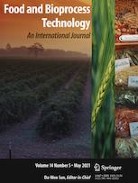Ver ítem
- xmlui.general.dspace_homeCentros e Institutos de InvestigaciónCIA. Centro de Investigaciones de AgroindustriaInstituto de Tecnología de AlimentosArtículos científicosxmlui.ArtifactBrowser.ItemViewer.trail
- Inicio
- Centros e Institutos de Investigación
- CIA. Centro de Investigaciones de Agroindustria
- Instituto de Tecnología de Alimentos
- Artículos científicos
- Ver ítem
Effects of High Hydrostatic Pressure and Beef Patty Formulations on the Inactivation of Native Strains of Shiga Toxin-Producing Escherichia coli O157:H7
Resumen
This study aimed to evaluate the effects of beef patty formulations and pressure levels on the inactivation of spoilage microbiota and native Shiga toxin-producing Escherichia coli (STEC) O157:H7. Beef patties were made with different salt and fat content (A: 1% NaCl – 10% fat, B: 2% NaCl – 10% fat, C: 1% NaCl – 20% fat and D: 2% NaCl – 20% fat) and treated at 400 and 600 MPa. STEC reductions after 400 and 600 MPa were 2 and 4 log CFU/g, respectively.
[ver mas...]
This study aimed to evaluate the effects of beef patty formulations and pressure levels on the inactivation of spoilage microbiota and native Shiga toxin-producing Escherichia coli (STEC) O157:H7. Beef patties were made with different salt and fat content (A: 1% NaCl – 10% fat, B: 2% NaCl – 10% fat, C: 1% NaCl – 20% fat and D: 2% NaCl – 20% fat) and treated at 400 and 600 MPa. STEC reductions after 400 and 600 MPa were 2 and 4 log CFU/g, respectively. STEC inactivation was similar in patties with 10 and 20% of fat content. However, patties with 1% of NaCl showed higher STEC reductions than those made with 2% of NaCl. The baroprotective effect of salt was probably related with the accumulation of compatible solutes, a well-known bacterial response to osmostress. After HPP treatment, all counts of spoilage microbiota were under the detection limit regardless of the formulation.
[Cerrar]

Fuente
Food and Bioprocess Technology 14 : 1-5 (May 2021)
Fecha
2021-04-08
Editorial
Springer
ISSN
0960-3085
Documentos Relacionados
Formato
pdf
Tipo de documento
artículo
Proyectos
(ver más)
INTA/PNAIyAV-1130033/AR./Tecnologías de preservación de alimentos y de aprovechamiento de subproductos.
INTA/PNAIyAV-1130042/AR./Herramientas y sistemas para la gestión de la calidad integral.
Palabras Claves
Derechos de acceso
Restringido
 Excepto donde se diga explicitamente, este item se publica bajo la siguiente descripción: Creative Commons Attribution-NonCommercial-ShareAlike 2.5 Unported (CC BY-NC-SA 2.5)
Excepto donde se diga explicitamente, este item se publica bajo la siguiente descripción: Creative Commons Attribution-NonCommercial-ShareAlike 2.5 Unported (CC BY-NC-SA 2.5)

